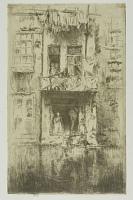Balcony, Amsterdam | ||
| Number: | 446 | |
| Date: | 1889 | |
| Medium: | etching and drypoint | |
| Size: | 272 x 169 mm | |
| Signed: | butterfly at right | |
| Inscribed: | no | |
| Set/Publication: | no | |
| No. of States: | 4 | |
| Known impressions: | 27 | |
| Catalogues: | K.405; M.404; W.262 | |
| Impressions taken from this plate (27) | ||
TECHNIQUE
It is an etching, drawn with fine broken outlines, the textures and shadows added with both fine etched and carefully integrated drypoint shading and cross-hatching, possibly rubbed down eventually with charcoal to soften the shadows further. The shadows and reflections were extended (suggesting that Whistler worked on this etching not just in the studio, but on site, at different times of day). In the later states, Whistler took pains to ensure that the central block of the building was differentiated from those at each side.
PRINTING
There was a print-run of over 30, not all of which have been located. The impression inscribed '1st proof pulled' was printed in black ink on ivory laid paper with an unidentified watermark (). It is the sole known impression of the first state. One impression of the second state () and one of the third () are in very dark brown ink, with rich surface tone in the water, on laid paper with an Arms of Amsterdam watermark. Another third state is in dark brown ink on cream laid 'Pro Patria' watermarked paper ().
Some impressions of the 'Amsterdam Set' were dated and numbered, for instance.
Balcony, Amsterdam dated '1. Mar. 6' ();
The Long House (The Dyers, Amsterdam) 453 dated '1 Mar 6' (), '2. Mar. 6' (), '4. Mar. 6' (), and '5. Mar. 6' ();
Bridge, Amsterdam 447 was also marked '3. mar. 6' ().
The Long House (The Dyers, Amsterdam) 453 dated '1 Mar 6' (), '2. Mar. 6' (), '4. Mar. 6' (), and '5. Mar. 6' ();
Bridge, Amsterdam 447 was also marked '3. mar. 6' ().
This suggests at least six impressions of Dutch etchings were printed on 6 March, and it may be that the duplication of the '1 March' numbering indicates prints selected for individual clients. Obviously some numbers have been lost, removed, or sre simply not visible (they were written in very small script) so the record is not complete.
The first - Balcony, Amsterdam - and second - Long House - Dyer’s - Amsterdam - impressions printed on 6 March 1890 were in dark brown ink on light-weight cream, Asian paper (, ). After that a variety of papers was employed.
Most impressions of Balcony, Amsterdam were made of the fourth state; some were printed in dark brown ink on a laid paper with 'PRO PATRIA' watermark (, possibly ). Others are in black ink on buff laid paper with a partial 'DHK' countermark (), and on ivory laid paper with foolscap watermark (), as well as in both brown (, ) and black ink () on ivory laid paper with the Arms of Amsterdam watermark, which was entirely appropriate. Some were printed in dark brown ink on ivory Asian paper (, ).
After Whistler's death, a small print-run of the final state was made at the request of Rosalind Birnie Philip (1873-1958) by Nathaniel Sparks (1880-1956). 8 One, reproduced below, was printed by Sparks in warm black ink on laid paper with a Foolscap watermark () and one in dark brown ink on ivory laid paper ().

On 18 June 1931 Sparks recorded:

On 18 June 1931 Sparks recorded:
8: Note, 18 June 1931, published in Martin Hopkinson, 'Nathaniel Sparks's Printing of Whistler's Etchings', Print Quarterly, 1999, Vol. 16, No. 4, pp. 340, 342, 349.
'The Balcony - Amsterdam - Printed from the proof presented by the Master to Drummonds Bank - In recognition of their kindness to him.
Seven proofs were pulled from this plate,
Two were destroyed & returned in pieces to Miss Burnie [sic] Philip. The two were bad prints.
The Five remaining being good proofs - ' 9
Seven proofs were pulled from this plate,
Two were destroyed & returned in pieces to Miss Burnie [sic] Philip. The two were bad prints.
The Five remaining being good proofs - ' 9
They were printed sympathetically, very closely following Whistler's printing methods. Sparks appears to have been given one impression by Miss Birnie Philip. Sparks added 'The plate is the property of Glasgow University & is never to be printed from again.' 10
10: Ibid., p. 352.
